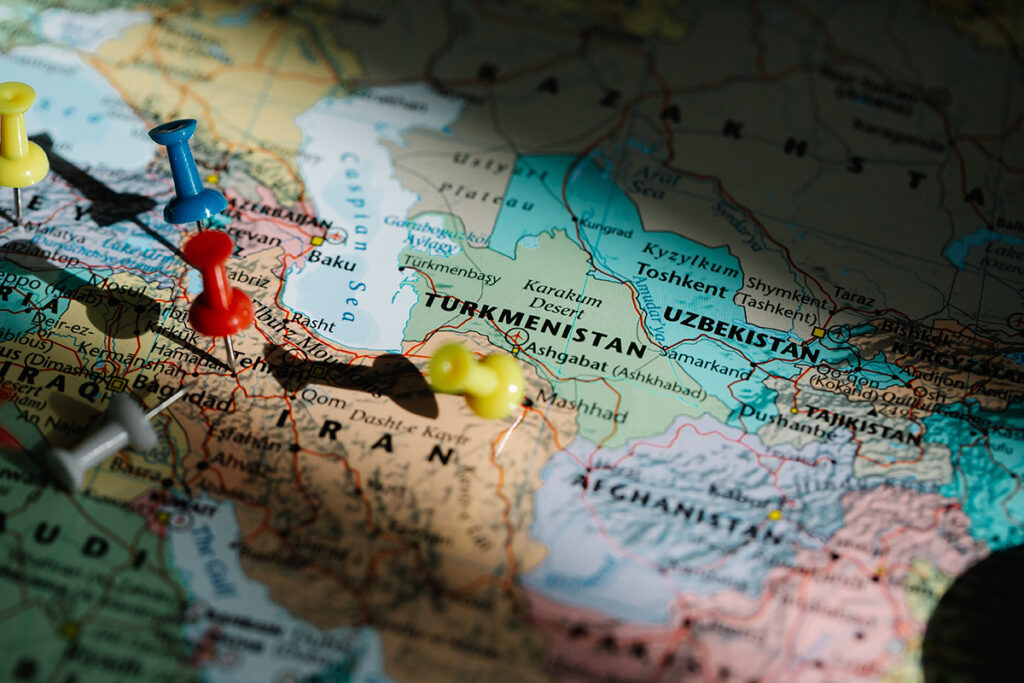Protests in Iran: Digital Blackouts May Not Be Final Word, Say Faculty

As Iranians — connected by outrage, oppression, and the internet — take to the streets to protest the death of a woman while in police custody for allegedly violating the Republic’s mandatory headscarf law, the regime in Tehran is cracking down, both with physical violence and technological sabotage.
Gino Canella, assistant professor of Journalism, said the current protest movement and subsequent crackdown reminds him of the Egyptian government’s shutdown of the internet during the Arab Spring of 2011.
“There seem to be two strategies from authoritarian governments when it comes to popular unrest and subversive communication,” said Canella, a documentary filmmaker whose research and creative projects explore media activism, grassroots organization, and how collaborative media production can foster meaningful relationships among people fighting for justice.
“One is to shut down internet access. The other is to ‘flood the zone,’ in other words, overwhelm online communication channels with so much garbage that people don’t know what to believe.”
Vincent Raynauld, associate professor of Communication Studies, who studies protest politics, social media, and identity politics, among other areas, said protest movements of this nature have arisen in Iran before, most notably the Green Revolution of 2009. In that movement, which was greatly facilitated by social media, Raynauld said, then-President Barack Obama actually asked Twitter, then still relatively new, to delay an update to the platform so Iranian protesters wouldn’t experience interruptions to their posts.
Despite the similarities, however, Raynauld said there are two facets of the current Iranian protests that stand out to him. One is the extent to which its driven by identity.
“This is something we’re seeing more and more when it comes to political protests, the notion of identity,” Raynauld said, noting that the impetus for uprising surrounds the forced wearing of the hijab. “There’s an identity component of the hijab, where there’s a religious component … but there’s also a gender component. Or it’s about women wanting to break free from male domination, but also wanting to break free from religious domination to some degree.”
Another difference between 2009 and 2022 is the type of content that’s being shared, he said. Thirteen years ago, when Twitter and Facebook dominated the social media landscape, most of the tweets and posts were very textual. Today, with the rise of Instagram, Snapchat, and now, TikTok, we’re seeing far more videos coming out of Iran.
“Video tends to be something that’s much more suggestive to the public,” Raynauld said. “So when you read about something, it’s very different from when you actually see something. [Video] has a more powerful appeal.”
But while it’s tempting to feel overly confident about the prospects for this particular movement, it’s important to realize that as Westerners, we have only a partial view of what’s actually happening based on what we see online, Raynauld said. The Green Revolution ultimately was quashed by the Iranian regime.
Social media is very useful for connecting people inside a system, and for bringing issue to the attention of people outside a system, he said, but it usually does not lead to political change.
Raynauld and Emma Richez, a colleague at the University of Windsor, published a study last year on Idle No More, a movement to defend sovereignty and tribal rights of Indigenous people in Canada, which is very much based around identity and culture, and utilizes social media, among other tactics.
“We actually found that despite the fact that there was more conversation about this in the political realm about the Indigenous issues, when it came to the passage of laws bettering the situation of Indigenous peoples in Canada, and when it came to the allocation of money … there was actually a decrease, despite this level of attention,” he said.
Raynauld said what’s necessary to bring about real change is political will inside a system, and sustained attention by the public and the wider society.
“[With] a lot of the big changes you saw in the United States or any other country, you saw sustained public attention to it over a long period of time,” he said. “That’s the main problem right now.”
It’s difficult to keep a movement in the public gaze without a central “brick and mortar” organization to propel a coherent narrative and keep it on the agenda for years or decades, he said.
The women who are removing their hijabs and showing their faces, risking identification and punishment, are extremely courageous, Raynauld said.
“Is there enough support internally for this movement, and more importantly, is there going to be sustained Western support, and I worry that maybe the Western world and other countries that are looking at this will move on to something else,” he said.
Canella said while he doesn’t have a lot of experience studying movements in the Middle East, based on his work with U.S. activists, the durability of the protesters’ social networks on the ground will be what ultimately determines the outcome.
It’s frustrating, Canella said, when news organizations credit phones and social media for drawing protesters into the streets.
“The statements ignore how the economic and political conditions on the ground have fostered widespread discontent among Iranians towards their government,” he said.
Social media and digital communication can help movements spread quickly, but if those are interrupted, protesters will need to rely on traditional organizing methods, including public assemblies, canvassing, and direct action, Canella said.
“If Iranian activists have the social infrastructure needed to organize those kinds of events, then internet blackouts may not be as effective as Iran’s leaders want them to be.”
Categories